Doing Irish research is not easy and involves a lot of getting familiar with the workings of the island itself in addition to doing the usual genealogical research. Thankfully, our Meara clan is a well-known one and much information exists – at least enough to tease out the basic backstory until such time as you can get into family particulars.
I’m not an Irish scholar by any means, and our particular ancestors have been playing hard-to-get over the course of my years of research, but with some clues from family members and a lot of scouring the latest databases on the internet, I believe I can finally share with you the story of our Meara ancestors and present it to you in some logical order. So let’s trace the family from their roots in Ireland all the way to Jersey City and beyond, right up until we come in.
The direct male ancestors of our known Mara’s run straight back to Tipperary, Ireland, to the land of the O’Meara’s of Toomevara.
According to Wikipedia, “The O’Mearas had an entensive territory in the barony; the name of their chief residence, Tuaim-ui-Meara, is still retained in the town of Toomavara.” Also, “The priory appears to have been strongly associated with the ruling O’Meara dynasty. Donogh O’Meara was building a castle here in 1541.”
Wilson, writing in 1786, refers to “Ballymakey” as the seat of Mr. O’Meara.
See this website for more detailed information on the O’Meara clan.
[NOTE: On your desktop computer you can right-click and open any of these images to view larger in another tab or window.]
We’ll start our exploration of Ireland with this colorful map of Ireland’s counties, which is the second level of land division in the country after the provinces. You can find County Tipperary in the southern, central part of the island, colored yellow (Munster province). Toomevara of the Meara’s is located near where the tail of Country Offaly (purple) pokes down into North Tipperary:
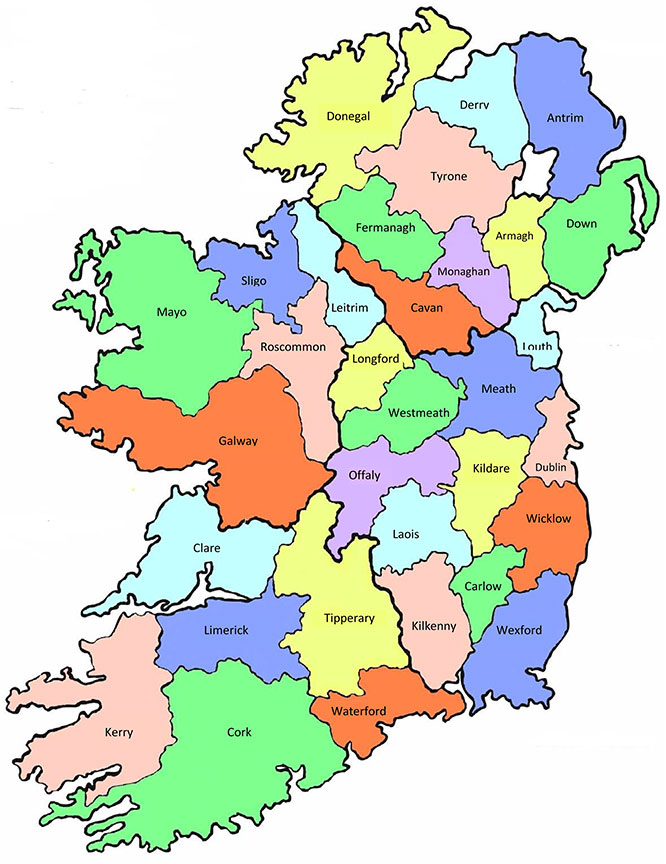
The next division of land after the counties are the baronies. There were six historic baronies in North Tipperary: Eliogarty, Ikerrin, Ormond Upper, Ormond Lower, Owney and Arra and Kilnamanagh Upper. (Ormond Upper is of interest to us.) And finally, the townlands.
You can see Toomevara marked red on the map below, in relation to Nenagh (at left), Ballymacky (center), Moneygall (right) and Dunkerrin (upper right). Each of these parishes and towns show up in the lives of our Meara ancestors.
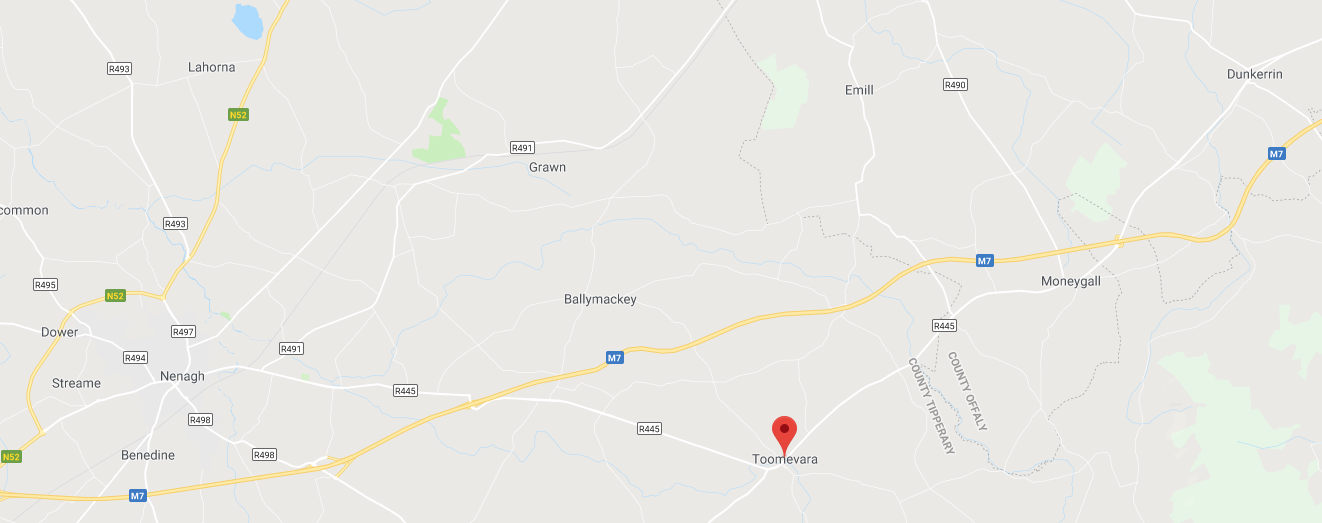
Back in 1989 I corresponded with family member Ed Mara (1921-2007) as we both poked around the genealogical records available at the time. This was the first time I heard of a “Morgan Mara” and it would be over two decades before I was able to find and confirm this information for myself:
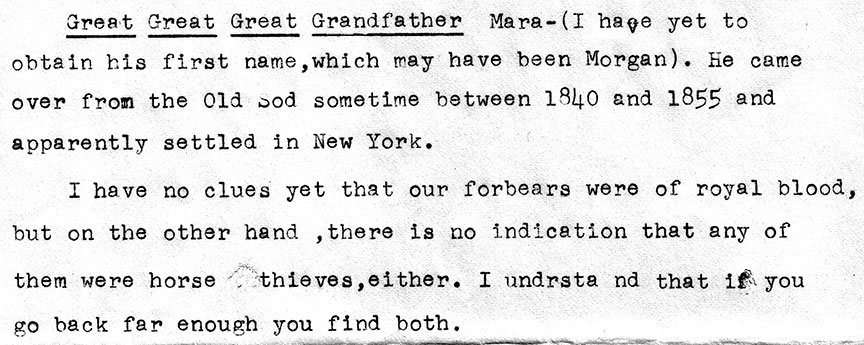
Various online records now help us locate our known ancestor Morgan Meara with a high degree of certainty and learn about key events in his life. I say “known” because he and his wife are referenced in marriage records pertaining to our more recent family members, thus proving the connection. Once you know who to look for, where they lived and where the information is online, the records come tumbling out of the woodwork!
Morgan’s 1839 residency in Kilgorteen (also spelled Kilgurtin with other variations), Ballymackey, County Tipperary (proven below in various censuses and other papers) is referenced in a document called “Occupation Of Land In Ireland”, with testimony from 1844 and 1845 (below) by a Mr. O’Brien Dillon recalling that earlier time of unrest in the area.
Note the mention of land owner John Boyd. A Joseph Boyd lived in Kilgorteen as well and had legal interactions with Morgan as his landlord:
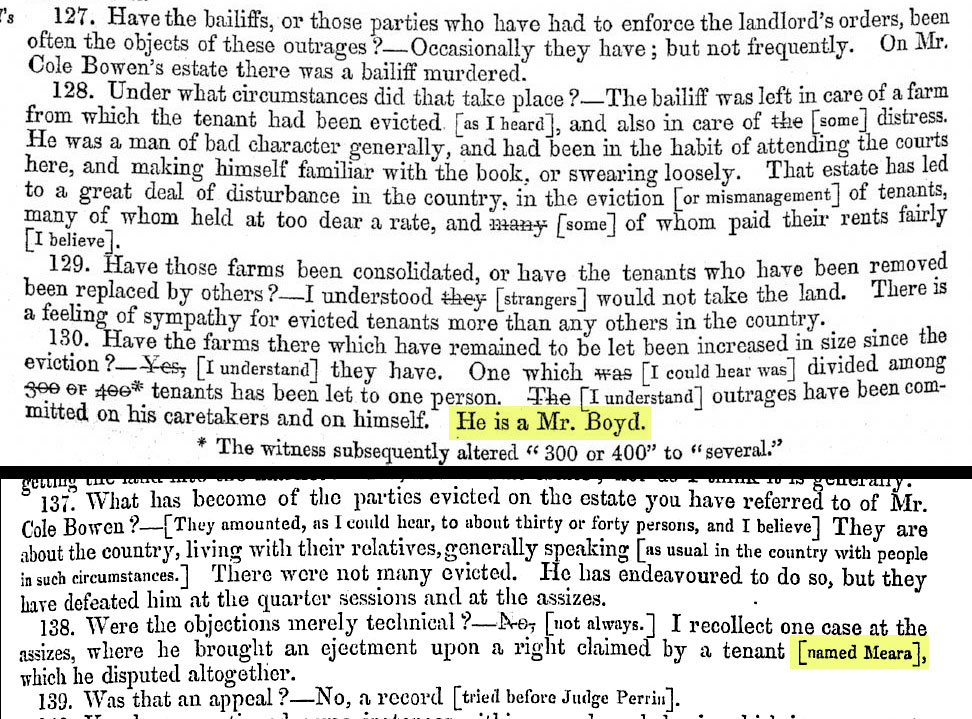
Morgan is actually singled out by name in this passage, which references the above document:
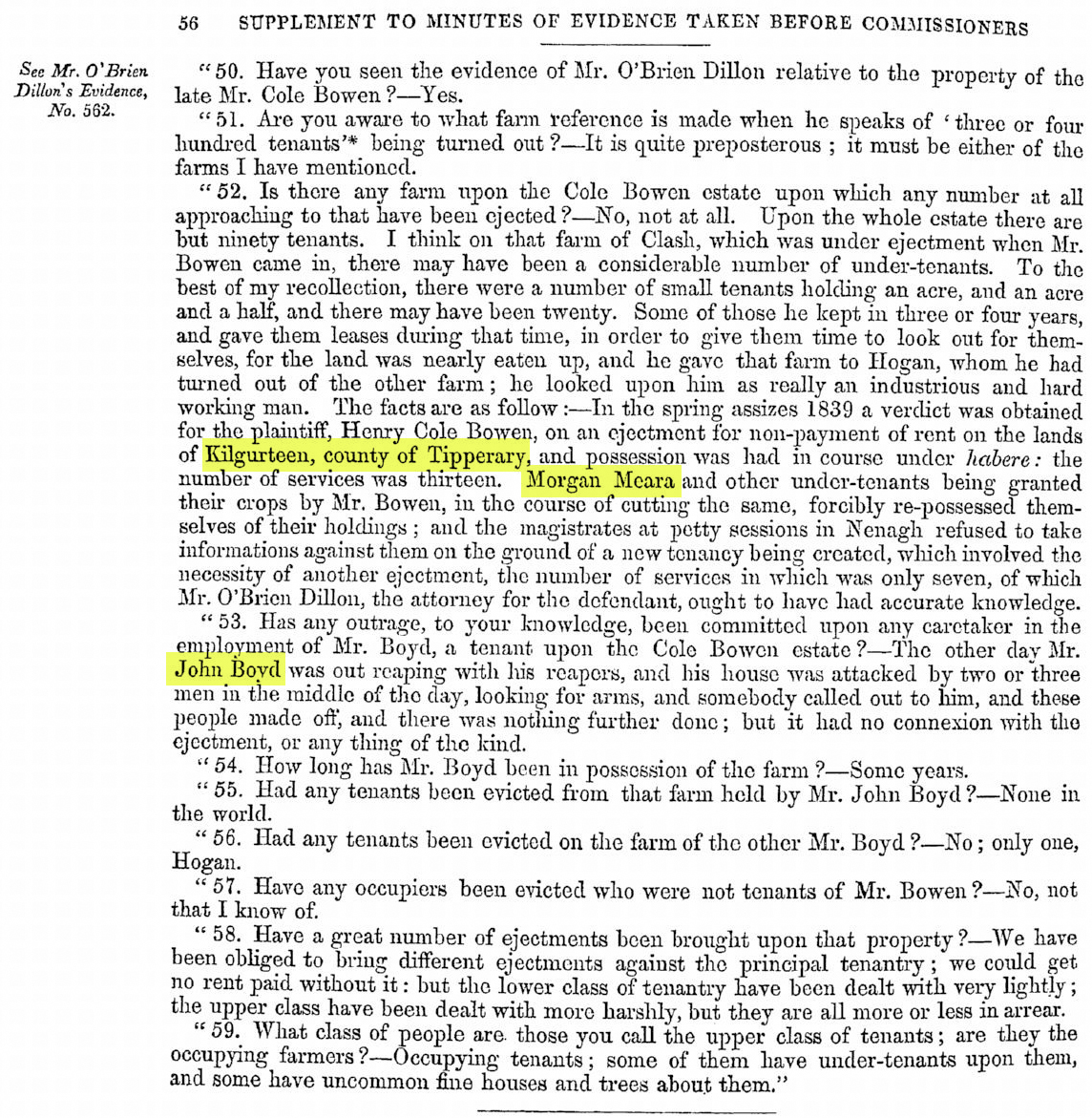
The Civil Proceedings at Petty Sessions, Nenagh for the years 1839, 1840, 1841 and 1842 show Morgan (alone and sometimes with other Meara’s, probably relatives) as either the complainant or defendant.
In October 1839 Morgan Meara of Kilgorteen was in some sort of trouble with John somebody from somewhere else and got fined:

Here is a case from April 1840 where Morgan and James and maybe Michael Meara were in some sort of trouble with landlord R. (Robert) C. (Cole) Bowen’s representative:

On November 7, 1842, Kilgorteen tenant Joseph Boyd complained about Morgan’s wandering and trespassing pigs (#4949):

That same day, Morgan was complaining about neighbor Boyd’s own horses and cows trespassing on his farm (below, #497 1-3):

In 1846 the Valuation Office recorded a Morgan Meara of Kilgorteen with a house, barn, stable and piggery (bottom of page). (A James Meara – probably a relative – is listed immediately afterward on the following page, not shown):
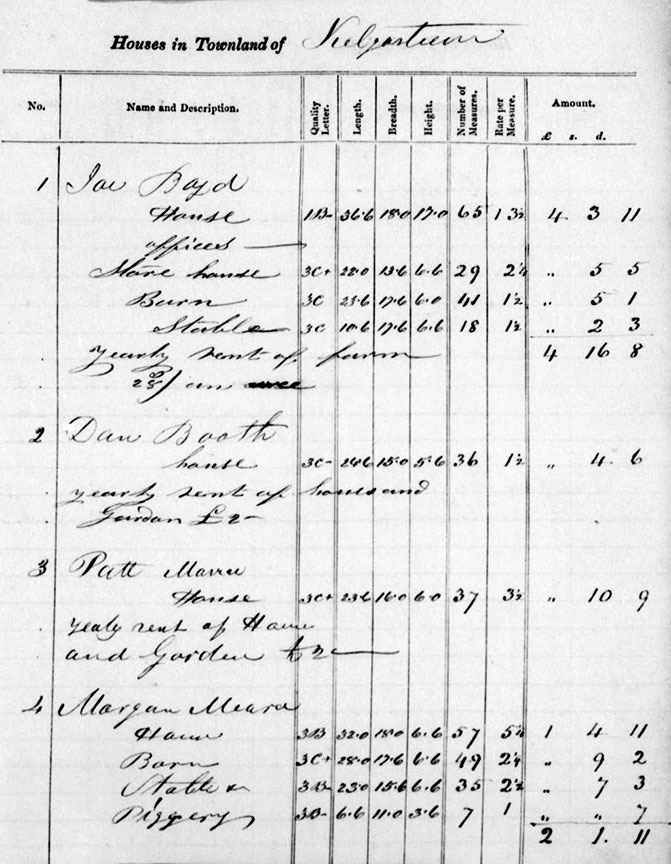
Griffith’s valuation (prepared between 1847-1864) in 1847 lists a Morgan Meara (among other Meara’s) and same neighbors Joseph Boyd and Daniel Booth living in Kilgorteen, parish of Ballymackey, Barony of Upper Ormond, County of Tipperary (a short distance northwest from Toomevara as shown in the map earlier). There’s also a Margaret Quirk living there; keep that surname in mind for later:
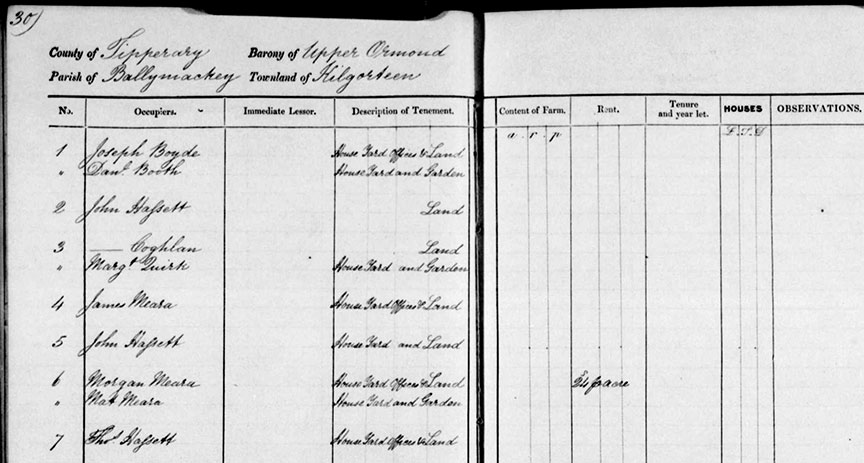
A printed version of the Valuation from 1850 shows the same area with some minor changes to the residents, but the Meara’s (with a swapping out of James and Matthew Meara and the addition of Stephen Meara) and Joseph Boyd, the Hassett’s, Margaret Quirk and the Coghlan’s are still there:
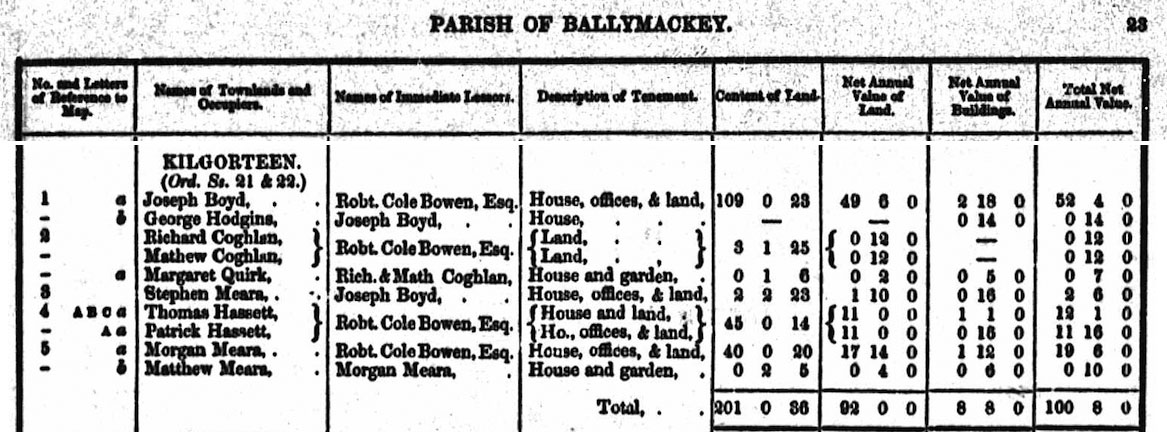
Note from the table above that Morgan Meara and some of his neighbors were renting from Robert Cole Bowen, mentioned in the printed page below from 1847.
“At the time of Griffith’s Valuation Robert C. Bowen held land in the parish of Kilbolane, barony of Orrery and Kilmore, county Cork and Ballymackey and Templedowney, barony of Upper Ormond, county Tipperary…” [source]; “The Bowen family of Welsh origin settled in Cork after Henry Bowen, a colonel in Oliver Cromwell’s army, received land there in 1653. In 1716, Henry Bowen of Kilbolane, Co. Cork married Jane Cole, heiress to the Ballymackey estate, and thus began the family’s Tipperary connection. This alliance greatly enhanced the fortunes of the Bowen family. The Ballymackey estate had originally been granted to Robert Cole during the Cromwellian period and unusually he chose to take up residence in his allocated lot. The Cole estate in Co Tipperary was situated in the Roman Catholic parish of Toomevara, which was comprised mainly of the civil parish of Ballymackey…” [source]
Here’s an 1871 valuation of part of Ballymackey Parish showing the number of homes and residents of Kilgorteen in 1841 (when the Meara’s were still living there), 1851 (just after they left) and later:

This 1840s map of Kilgorteen is referenced in the first column of the 1850 Valuation chart above, with the numbers and letters referencing the same figures on the map (showing where each person’s property was):
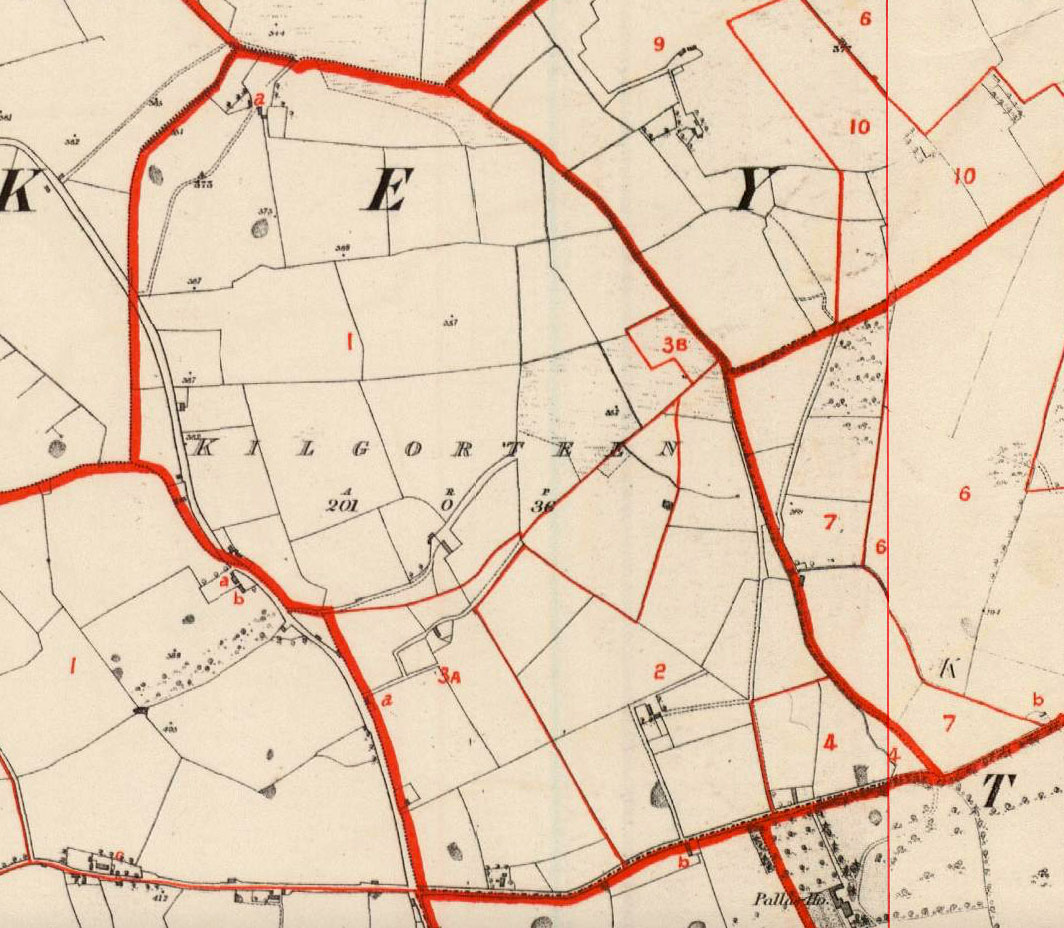
Morgan Meara was listed at #5, though the property does not appear on this map. Stephen Meara was living at #3.
Here’s a satellite view of Kilgorteen today. Notice how many of the property lines still exist, with a “new line” (the M7, built 2009) cutting through (this won’t be the last time a new road cuts through Morgan’s home, as we shall see in a later post):
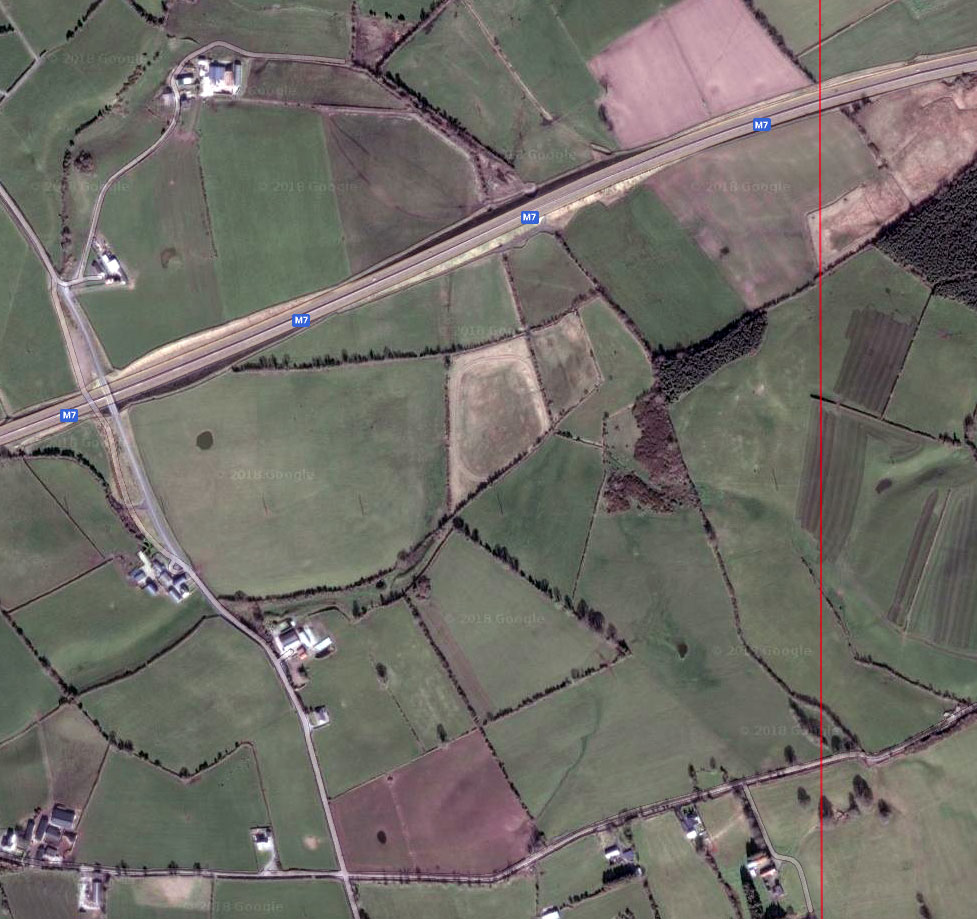
A modern view of Kilgorteen from the horizontal road at the south end of the townland, looking north:
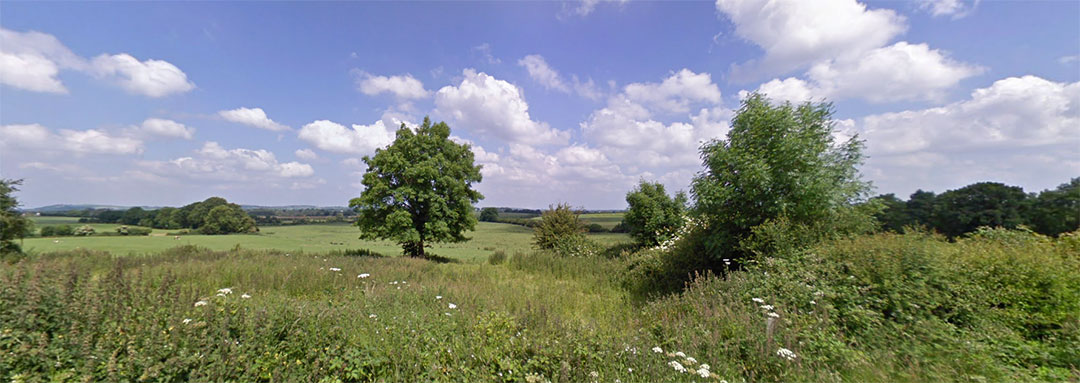
Here’s an outline of modern Kilgorteen (in red), shown in relation to nearby Toomevara, ancestral home to the Meara’s:
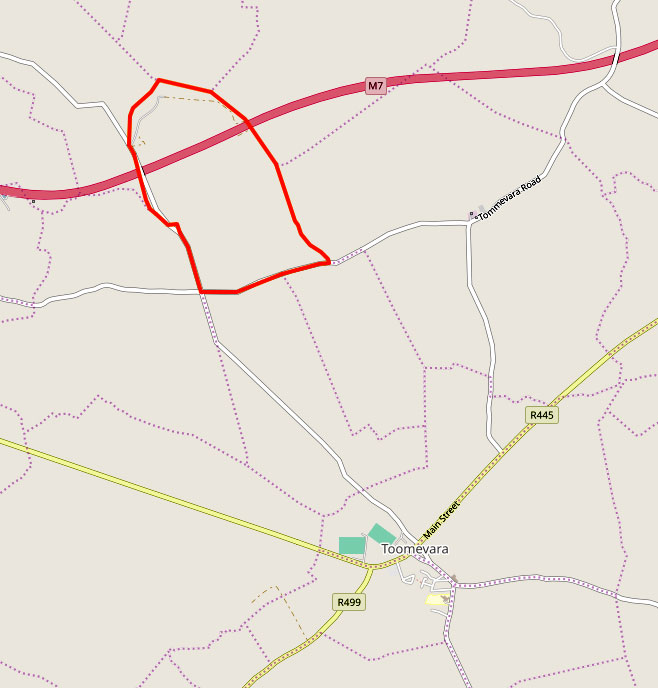
The Meara family seems to have some prior history in and around Kilgorteen specifically. In 1641, a Daniell Meara owned various properties circling Kilgorteen (shown on the map below; the one selected is a only few thousand feet west of Kilgorteen along the M7). Interestingly, he lost them to a Protestant Meara after the rebellion:
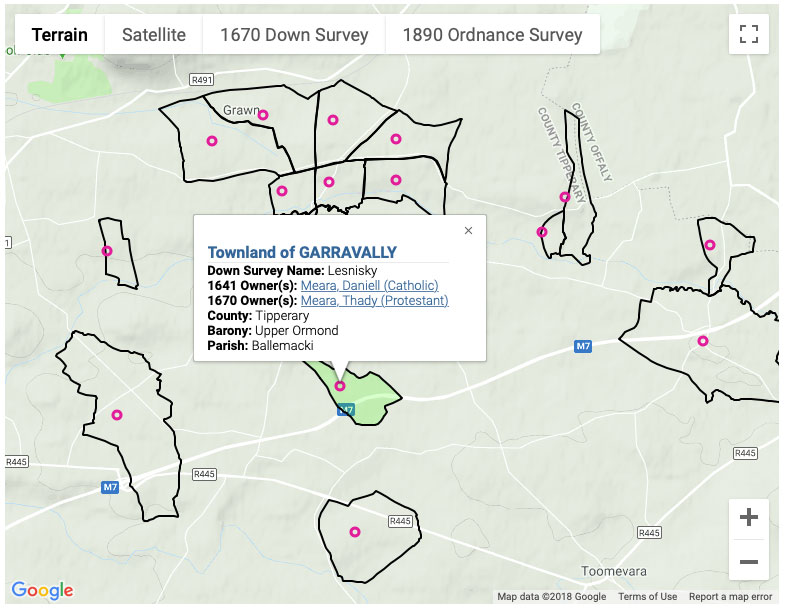
In 1824-5 we see John and Timothy Meara living in Kilgorteen (spelled “Kilgurtgan” here, from the Tithe Applotment Books). Morgan named his second son John, which may be a clue as to a possible family connection. Morgan’s youngest son Morris’ middle initial was “J” and Morris also named his son John Morris Mara (more in a later post).

(There was some talk in the Mara family about a possible connection to the NJ Giants Mara’s. I haven’t been able to make that connection but it’s interesting to note that Wellington Mara’s father was a Timothy, born 1887 in NY, and his father was a John. Both were born too late to be either of these Kilgorteen Meara’s, but the names are similar.)
In the 1840’s, Tipporary and even Kilgorteen were like the Wild West of Ireland, notorious for farm tenants rising up against their landlords and the landlords’ representatives (mainly regarding evictions/ejections) and attacking anyone who dared take possession of the lands of those evicted. Other types of random and targeted violence took place on the streets and in people’s homes on a regular basis. Skim through this ebook for an overview of the type of life the Irish people in general and the residents of Tipperary in particular led at the time. A sample quote from an inquest, published in 1845, sums up the situation:

On January 12, 1840, this ejection-related violence literally came into the home of one of the Meara’s living in Kilgurtin (either Morgan, Matthew, James or maybe Stephen):
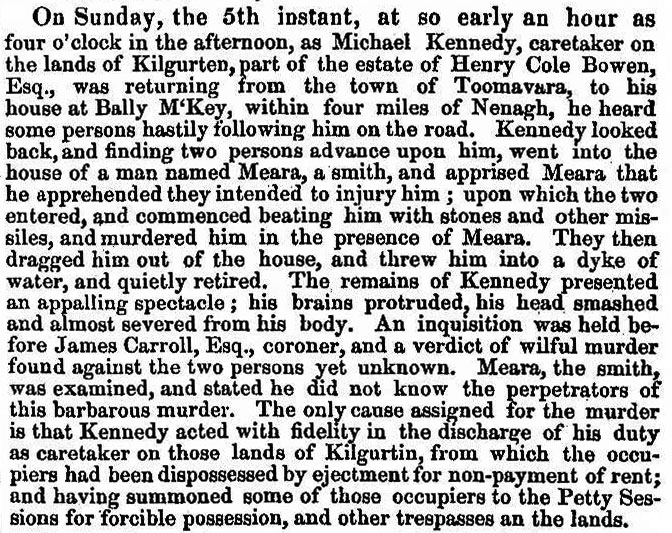
In early 1842, a native County Tipperary magistrate pleaded to the authorities for help with the lawless situation in his home area (sample excerpts are shown here):
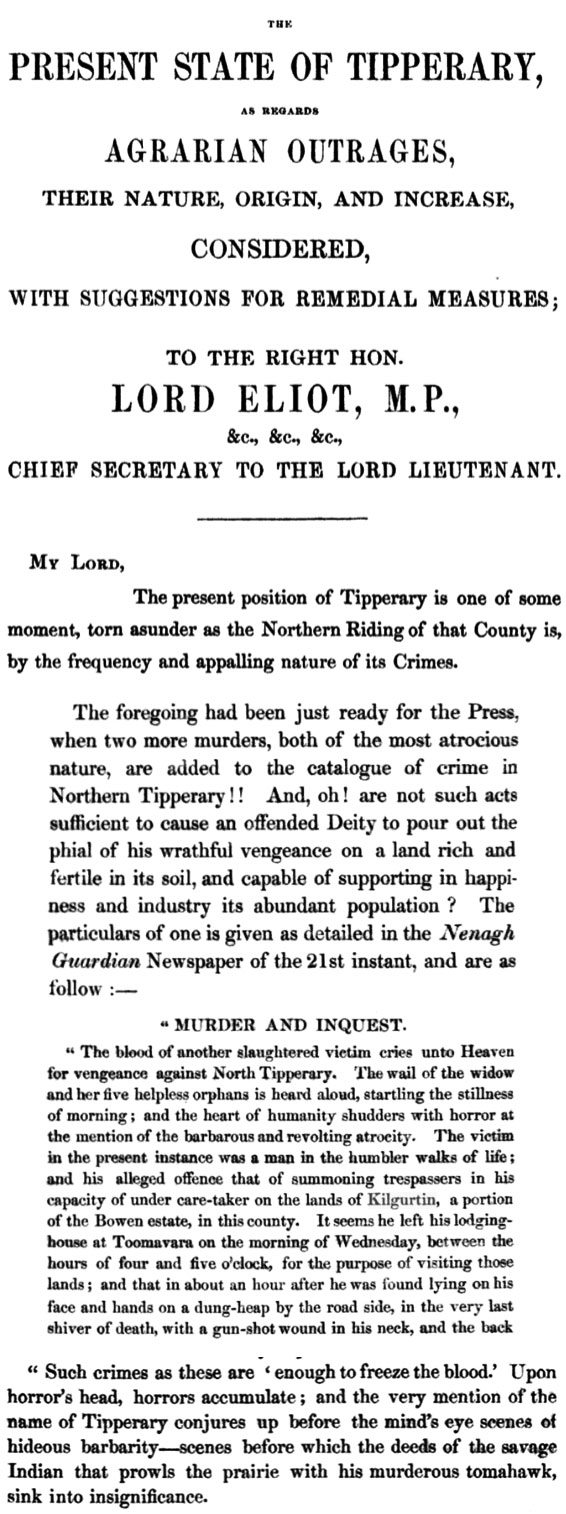
The year before, in June 1841, one of Morgan’s neighbors (Joseph Boyd, listed on the same Valuation page as Morgan) had his gun stolen:
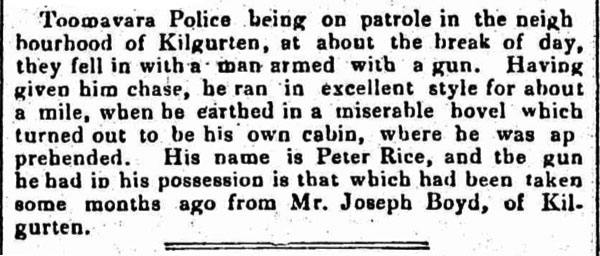
In April 1846, a Morgan Meara (hopefully not ours, but seemingly so) and various Cormack’s are arrested for murder and seemingly held in the nearby Nenagh gaol/prison until the next assize (criminal court) took place:

At the beginning of August 1846, sentences for the various Cormack’s (here “Cormac” but the first names are the same or similar) and Morgan (plus a Hugh) “Mara” are handed down. Morgan in particular got one year at hard labor. As we will see below, Morgan’s son John was probably born in December 1846 (baptized January 2, 1847), so if this is indeed our Morgan in prison from April 1846 until August 1847, he missed his wife’s entire pregnancy, the birth of John and John’s first eight months of childhood (assuming they didn’t visit him in prison):
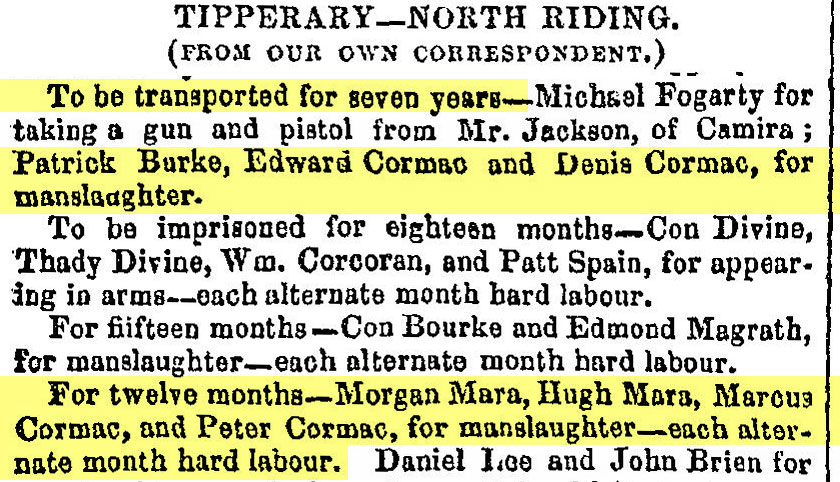
In 1847, the Commissioners of Inquiry into the State of the Law and Practice in Respect to the Occupation of Land in Ireland (Digest of Evidence taken before Her Majesty’s Commissioners, etc.) described (question #28) Kilgorteen (and seemingly Morgan’s exact farm area) as a hotbed of “agrarian outrages” that even included murder, so the above court case is not an anomaly:
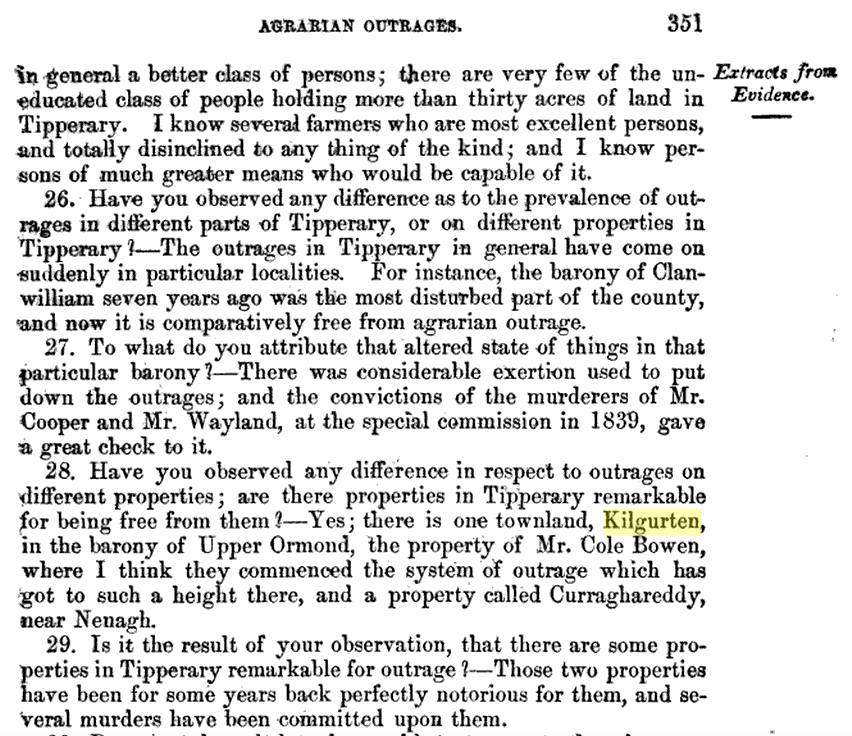
In August 1848, farm animals on the Kilgorteen farms were attacked by some unknown assailants:

And again in October 1848, other persons came onto the same land for revenge after a James Meara (see 1847 valuation above) and another person had been evicted, and took it out on some horses belonging to Morgan Meara’s neighbor Thomas Hassett (see 1850 valuation):
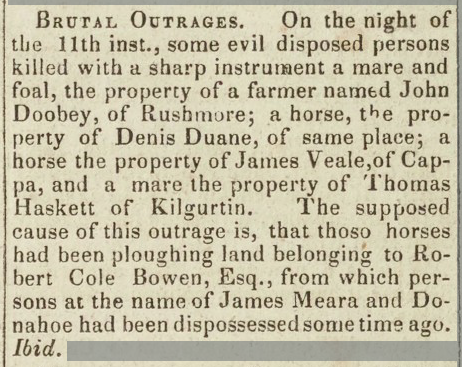
So it was in this violent place and on the cusp of a national famine that Morgan Meara lived and began his own family… But before we introduce Morgan’s wife and descendants, we’ll look at his (and our) probable ancestors:
[MICHAEL/DANIEL MEARA – INFO TO BE ADDED]
Now we’ll catch up to describe Morgan’s marriage in the middle of the above outrage incidents:
On February 19, 1844, Morgan married Honor(a) Stapleton in Dunkerrin (which as we’ll see below is just a short distance from the Meara haunts of Toomevara and Kilgorteen). Here is the actual record of the marriage:
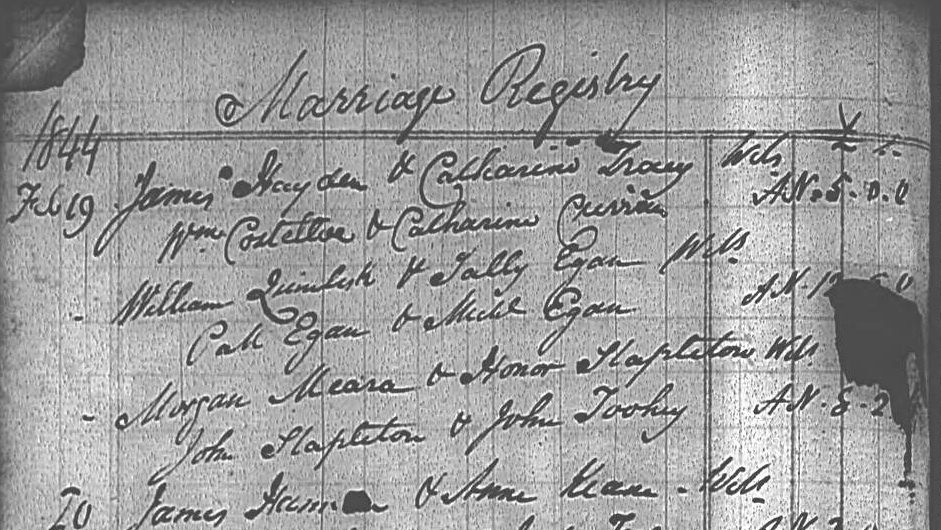
The marriage was witnessed by John Stapleton and John Toohy. John Stapleton is obviously some relative of Honor’s (brother? Father?), while I understand that the Toohy’s had some family connection with the Meara’s.
A transcript of this same record appears like this:
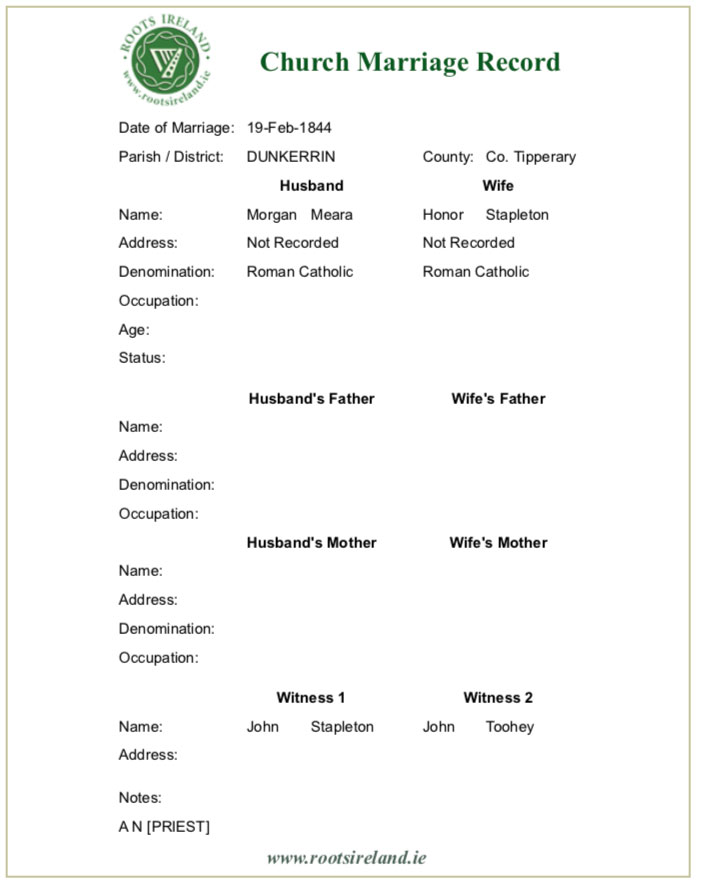
There is a church right in the middle of Dunkerrin and the only one in the area, today called the Dunkerrin Church of Ireland. It was built in 1818 and may well be the church in which the Meara’s were married in 1844:


Dunkerrin is in County Tipperary, according to the marriage record (or County Kings/Offaly according to modern maps; either way it’s right on the border of the two):

An 1838 map of Dunkerrin overlaid upon a modern day satellite image shows how little the area has changed over the centuries:
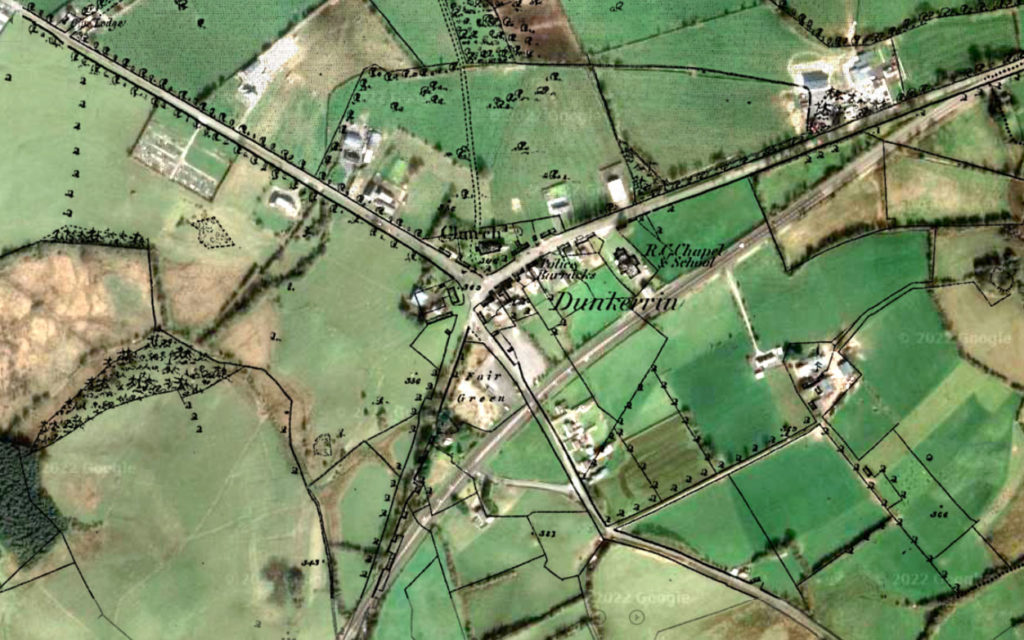
This map shows the relation between Morgan Meara’s Kilgorteen (highlighted in red at left) and Dunkerrin at upper right:
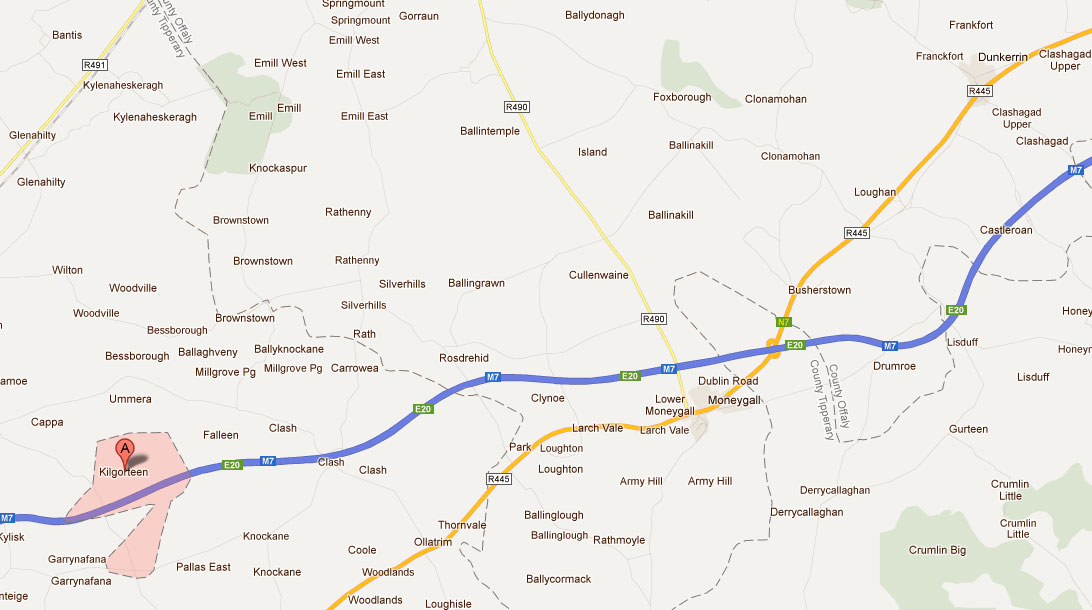
This map (below) shows the relation between Ballymackey and Toomevara (lower left) and Dunkerrin (upper right):
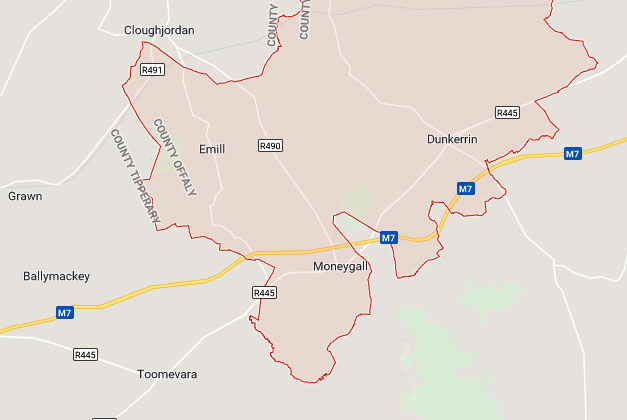
Here’s how Dunkerrin looks from the ground today (exactly as you’d expect):
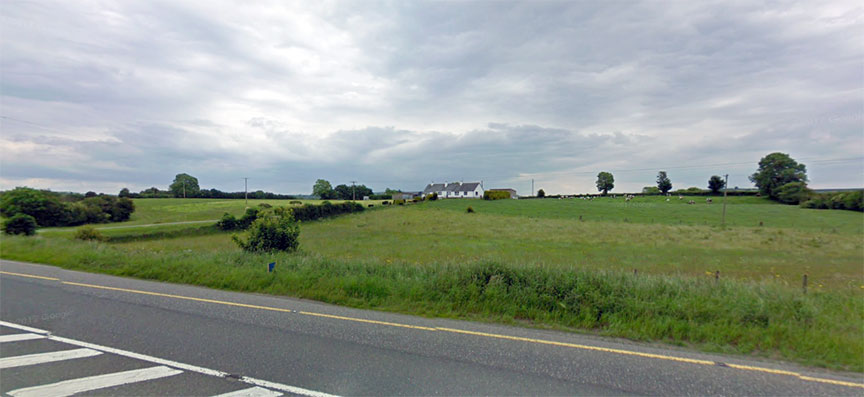
On November 3, 1844 (two weeks shy of nine months after the Meara’s married) a Honora Meara of Kilgorteen is mentioned in the Toomevara>County of Tipperary>Diocese of Killaloe book of baptisms. As everything else in the entry is mostly unreadable, I don’t know if this refers to Morgan’s wife Honora or a daughter named after her mother or somebody totally different:

However, on September 24, 1845, a James Meara was born to the Kilgurtin couple and his arrival clearly recorded. Morgan is called “Morry” (later on in New York we’ll see him listed as “Murray”, which sounds similar), last name spelled “Mara”. As an added bonus, we are introduced to some new family members, Michael Mara and Bridget Stapleton (exact relation currently unknown):

In December 1846, Morgan and Honor/Honora had a son John [middle name Ignatus, as we learn later], whose birth record reads like this:
Name: John Meara
Date of Birth:
Date of Baptism: 02-Jan-1847
Address: Kilgurtin Parish
District: TOOMEVARA
Gender: Male
County Co. Tipperary
Denomination: Roman Catholic
Father: Morgan Meara
Mother: Honor Stapleton
Occupation:
Sponsor 1 /
Informant 1: Michael Guilfoyle
Sponsor 2 /
Informant 2: Honor Guilfoyle
Here is the actual handwritten record:

(BTW, John made the transatlantic emigration voyage to New York with his parents and lived to adulthood. More on him later.)
Notice “Informant 1”, Michael Guilfoyle. He appears in the 1847 record further above in this blog post, but on the previous page, placing him in proximity of Morgan (friend, neighbor, relative?):
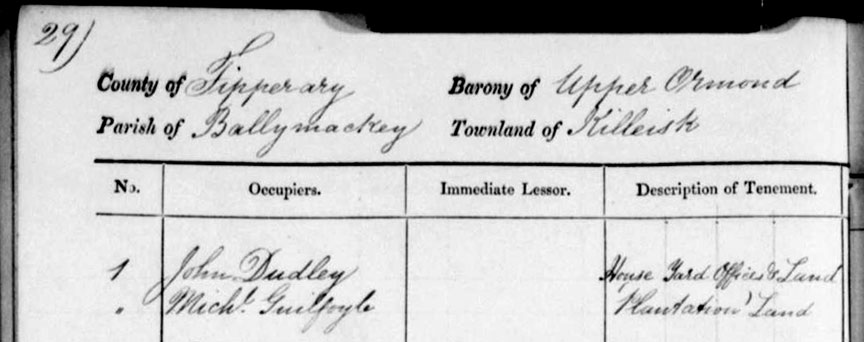
As of this moment the other Meara’s, Stapleton’s, Toohy’s and Guilfoyle’s remain a bit of a mystery which we’ll leave for another time (BTW, we who are descended from Morris Mara, son of Morgan, are also related to Irish families such as Stapleton, Morris, Sweeney, Murphy, Reilly, Keane, O’Brien and others).
In the meantime we have more pressing matters: Irish evictions and the Potato Famine (September 1845-1852) have begun!
Shortly before their departure for America, things got even worse for the Meara’s. On February 20, 1850, Morgan, said to be age 45, was imprisoned (possibly not for the first time) in the County Gaol in Nenagh, this time as a pauper indebted to landlord Robert C. Bowen (see #24 in the document below). A couple weeks later on March 8, the debt was settled and Morgan was discharged:

This is a remaining cellblock and courthouse at the Nenagh gaol:

With all that was happening to them and the land and their countrymen around them, the Meara’s couldn’t get out of Ireland fast enough… Little James Meara and possibly an older child as described above don’t make it to summer 1850 when Morgan, Honora and little John, age 3, left for America (with unborn William along for the ride).